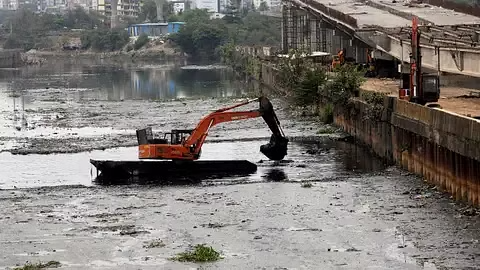The Sabarmati is the second most polluted river in India after the Cooum river in Tamil Nadu, according to a Central Pollution Control Board (CPCB) November 2022 report tabled by the Union ministry of Jal Shakti.
The CPCB data identified 311 polluted stretches on 279 rivers based on monitoring results in terms of biochemical oxygen demand (BOD), an indicator of organic pollution.
According to the report, the stretch of Sabarmati between Raysan in Gandhinagar and Vautha in Dholka had a BOD of 292 milligram per litre. Despite the suo motu intervention by the Gujarat High Court in August 2021 to rein in river pollution, followed by a series of interventions by a court-appointed nine-member joint task force, the ecological status of the Sabarmati has only gone from bad to worse in the past five years. Far from being a lifeline, it is now the second most polluted river in India. This was revealed during the parliamentary proceedings.
The National Green Tribunal (NGT) order of 2018 had stated that the Biochemical Oxygen Demand (BOD) level – one of the main indicators of organic pollutants- of the Sabarmati between Kheroj and Vautha was between 4 mg/l to 147 mg/l.
However, the Central Pollution Control Board’s (CPCB) report of November 2022, has stated that the BOD level in the Sabarmati between Raysan in Gandhinagar and Vautha in Dholka was 292 mg/l. The CPCB has now categorized Sabarmati under Category-I which makes it ‘critically polluted’.
The data tabled by the Union Ministry of Jal Shakti reveals that Sabarmati is the second most polluted river in India after the Cooum river in Tamil Nadu. According to the norms laid out by the CPCB, a river is fit for bathing if its BOD level is less than 6 mg/l whereas water with BOD level less than 2 mg/l is considered safe for drinking.
The CPCB has identified 311 stretches on 279 rivers in the country that are polluted mainly because of untreated sewage being released into the water bodies.
The blatant discharge of untreated sewage into the rivers is the key cause of pollution. Along the specified stretch of the Sabarmati, a slew of textile manufacturing and processing units are situated in addition to chemical manufacturing units. In December 2021, the Ahmedabad Municipal Corporation (AMC) severed drainage connections of 250 industrial units including Ankur Textiles in Raipur, Arvind Ltd in Naroda, and Ashima Ltd in Khokhra, among others.
Also Read: Vastrapur Lake Area Plagued by Rats












